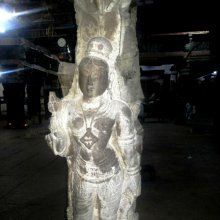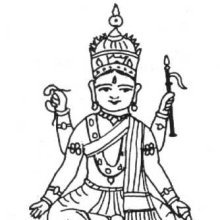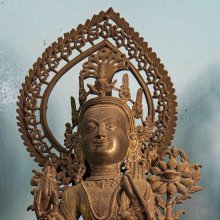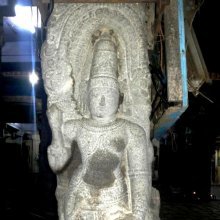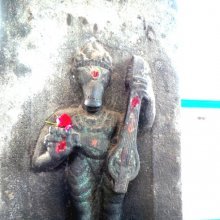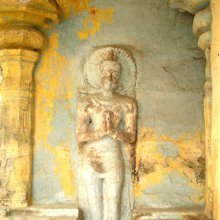Gandharva, Gāndharva, Gamdharva, Gamdharvadurve: 43 definitions
Introduction:
Gandharva means something in Buddhism, Pali, Hinduism, Sanskrit, Jainism, Prakrit, the history of ancient India, Marathi. If you want to know the exact meaning, history, etymology or English translation of this term then check out the descriptions on this page. Add your comment or reference to a book if you want to contribute to this summary article.
Images (photo gallery)
(+3 more images available)
In Hinduism
Purana and Itihasa (epic history)
Source: Wisdom Library: Varāha-purāṇaGandharva (गन्धर्व).—One of the nine divisions of Bhārata, a region south of mount Meru, according to the Varāhapurāṇa chapter 74. Gandharva is surrounded by an ocean (sāgara) and is one thousand yojanas in extent. Meru is one of the seven mountains located in Jambūdvīpa, which is ruled over by Āgnīdhra, a grandson of Svāyambhuva Manu, who was created by Brahmā, who was in turn created by Nārāyaṇa, the unknowable all-pervasive primordial being, who was created by Brahmā, who was in turn created by Nārāyaṇa, the unknowable all-pervasive primordial being.
Source: Google Books: Cultural History from the Vāyu PurānaThe Gandharvas of the Vāyu-purāṇa are connected with the ritual especially in connection with the chanting of the Sāmaveda. In the Vedas they are no doubt associated with the ritual and especially with Soma and not with the Sāmaveda.
Source: archive.org: Puranic Encyclopedia1) Gandharva (गन्धर्व).—Gandharvas are sons born to the famous Kaśyapaprajāpati of his wife, Ariṣṭhā (Agni Puraṇa, Chapter 19). Both belonged to the race of the Devas.
2) Gandharva (गन्धर्व).—A King born in the dynasty of Janamejaya. (Bhāgavata, Navama Skandha).
3) Gāndharva (गान्धर्व).—A marriage settled by the boy and the girl of their own accord. A love marriage. There are six different kinds of marriage: Gāndharva, Ārṣa, Prājāpatya, Rākṣasa, Āsura and Paiśāca. (See under Vivāha).
Source: Cologne Digital Sanskrit Dictionaries: The Purana Index1a) Gandharva (गन्धर्व).—A Kādraveya Nāga,1 lives in trees.2
- 1) Brahmāṇḍa-purāṇa III. 7. 36: Vāyu-purāṇa 61. 79: 62. 100: 69. 73: 100. 159: 101. 3 and 28: 106. 59.
- 2) Brahmāṇḍa-purāṇa I. 7. 84: 8. 40.
1b) A kingdom noted for horses;1 a division of the Bhāratavarṣa.2
- 1) Brahmāṇḍa-purāṇa IV. 16. 17: Matsya-purāṇa 114. 8: 121. 48.
- 2) Vāyu-purāṇa 45. 79: Viṣṇu-purāṇa II. 3. 7.
1c) A god to be worshipped in housebuilding.*
- * Matsya-purāṇa 253. 25.
1d) The fourteenth kalpa; here Gāndhārasvara and Nāda came into being.*
- * Vāyu-purāṇa 21. 32.
1e) Born of Ariṣṭā and Kaśyapa;1 worshipped for personal beauty;2 sent by Indra to disturb Mārkaṇḍeya's tapaṣ;3 killed in crores by Bharata;4 other references to.5 A gaṇa moving with the sun by turns praising him;6 sang Sāma in Vāruṇī yajña.7 Three steps inferior to gods; semidivine like Yakṣas, Rākṣasas and Piśācas; frequent Kailāsa; vanquished by Rāvaṇa; Citraratha was their overlord.8 milked the earth and preserved its essence Gandha (s.v.); worship Barhiṣad manes; attended with Apsaras at the yajña of Arjuna Kārtavīrya;9 world of;10 live in trees,11 ety. from singing;12
- 1) Matsya-purāṇa 5. 1: 6. 29 and 45: Viṣṇu-purāṇa I. 5. 46: 21. 25.
- 2) Bhāgavata-purāṇa II. 3. 6.
- 3) Ib. XII. 8. 16.
- 4) Ib. IX. 11. 13.
- 5) Ib. IV. 6. 9: V. 1. 8; VI. 7. 3; VII. 7. 50; 8. 38; X. 3. 6: 4. 11: 25. 31: 55. 23: 62. 19; 85. 41; XI. 6. 3: 12. 3: 14. 5: 16. 33: 31. 2: XII. 11. 47: Brahmāṇḍa-purāṇa IV. 1. 155: 2. 26: 4. 2: 9. 77: 15. 24: 20. 48 and 101: 33. 15: 39. 56.
- 6) Brahmāṇḍa-purāṇa II. 23. 27 and 50: 32. 1-2: 35. 191.
- 7) Brahmāṇḍa-purāṇa III. 1. 25.
- 8) Brahmāṇḍa-purāṇa III. 7. 167-70, 255: 8. 10: 10. 37: 24. 59. IV. 36. 16: Matsya-purāṇa 8. 6.
- 9) Matsya-purāṇa 10. 24: 13. 17; 15. 3; 37. 2 and 4: 43. 22.
- 10) Matsya-purāṇa 78. 11: 246. 61: 247. 11.
- 11) Brahmāṇḍa-purāṇa II. 7. 84: Vāyu-purāṇa 9. 55: 21. 33: 30. 86: 33. 64: 34. 55.
- 12) Brahmāṇḍa-purāṇa II.
13) Vāyu-purāṇa 66. 73.
1f) (Mauneya) in number 60 crores, overcame the Nāgas of Rasātala and deprived them of their jewels, etc.; ultimately defeated by Purukutsa, son of Māndhāta.*
- * Viṣṇu-purāṇa IV. 3. 4-9.
2a) Gāndharva (गान्धर्व).—One of the nine divisions of Bhāratavarṣa.*
- * Brahmāṇḍa-purāṇa II. 16. 9. Matsya-purāṇa 48. 7.
2b) A form of marriage by which Kṛṣṇa married Rukmiṇī, and Duṣyanta married Śakuntalā. Princesses usually chose their husbands.*
- * Bhāgavata-purāṇa III. 3. 3; IX. 20. 15-16; Brahmāṇḍa-purāṇa IV. 15. 5; Viṣṇu-purāṇa III. 10. 24.
2c) The science of music; a vidyā; mūrchanas and their lakṣaṇas in;1 the music displayed at the court of Brahmā; also the music played upon by Kṛṣṇa.2
- 1) Vāyu-purāṇa 86. 26, 36-69. Viṣṇu-purāṇa III. 6. 28.
- 2) Bhāgavata-purāṇa IX. 3. 30; X. 21. 5[1]; Brahmāṇḍa-purāṇa III. 61. 21, 26-8.
Gandharva (गन्धर्व) is a name mentioned in the Mahābhārata (cf. I.59.7, I.65, I.61.62) and represents one of the many proper names used for people and places. Note: The Mahābhārata (mentioning Gandharva) is a Sanskrit epic poem consisting of 100,000 ślokas (metrical verses) and is over 2000 years old.
Source: Shodhganga: The saurapurana - a critical studyGandharva (गन्धर्व) refers to the offspring of Ariṣṭā: one of thirteen of Dakṣa’s sixty daughters given to Kaśyapa in marriage, according to one account of Vaṃśa (‘genealogical description’) of the 10th century Saurapurāṇa: one of the various Upapurāṇas depicting Śaivism.—Accordingly, Dakṣa gets married to Asikni, the daughter of Prajāpati Viraṇa and begot sixty daughters [viz., Kaśyapa]. Kaśyapa’s thirteen wives are [viz., Ariṣṭā]. Gandharvas were born to Ariṣṭā.

The Purana (पुराण, purāṇas) refers to Sanskrit literature preserving ancient India’s vast cultural history, including historical legends, religious ceremonies, various arts and sciences. The eighteen mahapuranas total over 400,000 shlokas (metrical couplets) and date to at least several centuries BCE.
Vaishnavism (Vaishava dharma)
Source: ISKCON Press: GlossaryGandharva (गन्धर्व).—The celestial demigod dancers, singers, and musicians of the heavenly planets.

Vaishnava (वैष्णव, vaiṣṇava) or vaishnavism (vaiṣṇavism) represents a tradition of Hinduism worshipping Vishnu as the supreme Lord. Similar to the Shaktism and Shaivism traditions, Vaishnavism also developed as an individual movement, famous for its exposition of the dashavatara (‘ten avatars of Vishnu’).
Natyashastra (theatrics and dramaturgy)
Source: Wisdom Library: Nāṭya-śāstra1a) Gandharva (गन्धर्व) refers to a group of deities to be worshipped during raṅgapūjā, according to the Nāṭyaśāstra 3.1-8. Accordingly, the master of the dramatic art who has been initiated for the purpose shall consecrate the playhouse after he has made obeisance (e.g., to gandharvas).
1b) Gandharva (गन्धर्व) refers to a “musician” who can be assigned the role of an assesor (prāśnika) of dramatic plays (nāṭaka) according to the Nāṭyaśāstra chapter 24. These assessors (e.g., the gandharvas) are to point out the faults of a dramatic performance (nāṭaka) as well as the merits of actors (nartaka) whenever a controversy (saṃgharṣa) arises among persons ignorant of the nāṭyaśāstra.
2) Gāndharva (गान्धर्व) refers to “musical performance” composed of notes, time-measure and verbal themes, according to the Nāṭyaśāstra chapter 28. It is a combination of vocal music and the music of instruments:—“that which is made by the stringed instruments (ātodya) and depends as well on various other instruments, and consists of savra (notes), tāla (time-measure) and pada (verbal theme) should be known as the gāndharva. As it is very much desired by gods and as it gives much pleasure to Gandharvas, it is called the gāndharva (i.e. a thing belonging to Gandharvas.)”
Gāndharva (musical performance) is of three kinds:
- that of the notes (svara),
- that of the time-measure (tāla),
- that of the verbal theme (pada).
Gāndharva (गान्धर्व, “music”).—In ancient times music is indicated by the word gāndharva. By later authors, however, it is called gīta or saṃgīta. In Vedic texts the term gāndharva does not occur. We find the following musical terms: vādita for instrumental music, gīta for vocal music and gātha to indicate originally religious, later on also secular musical recitations (“sprechgesang”) or songs in a simple recitative style in contradistinction to the more complicated sāman-melodies.
According to Dattilam, “in the very beginning music (gāndharva) was given by the Self-existing One (Svayambhū) to Nārada and the other gandharvas. Then, it was duly taken down to the earth by Nārada. A collection of notes (svara), which is based on words (pada), which is well-measured by time-measurement (tāla) and which is executed with attentiveness, is called music (gāndharva).”
According to Nāṭyaśāstra 28.9: “as it is very much desired by gods and as it gives much pleasure to Gandharvas, it is called the gāndharva (i.e. a thing belonging to Gandharvas)”.
According to the Saṃgītaratnākara 4.2: “that, which from eternity exists as a traditional and which is always performed by celestial musicians as something which brings happiness, is what the experts call gāndharva”.
Source: Google Books: Saṅgītaśiromaṇi: A Medieval Handbook of Indian MusicGāndharva (गान्धर्व, “classical music”).—That which master musicians (gandharva) have been performing in an unbroken tradition down to thhis day—prakaraṇa songs and other compositions vased on fundamental melodic forms (grāmarāga), modes (jāti), etc.—is classical music (gāndharva). (cf. Saṅgītaśiromaṇi 13.1)
Source: archive.org: Natya ShastraGandharva (गन्धर्व).—Description of a women of gandharva type;—A woman who enjoys roaming in many gardens, is adorned with good nails and teeth, speaks with a smile, is slim-bodied, has a slow gait, loves sexual pleasure, is always pleased to hear music (gīta and vādya) and to witness dance, is careful about cleanliness of the body and has soft skin, glossy hairs and charming eyes, is known to possess the nature of a gandharva.

Natyashastra (नाट्यशास्त्र, nāṭyaśāstra) refers to both the ancient Indian tradition (shastra) of performing arts, (natya—theatrics, drama, dance, music), as well as the name of a Sanskrit work dealing with these subjects. It also teaches the rules for composing Dramatic plays (nataka), construction and performance of Theater, and Poetic works (kavya).
Dhanurveda (science of warfare)
Source: Wisdom Library: DhanurvedaGāndharva (गान्धर्व) refers to a weapon (Arjuna received this weapon from tribe Tumbari (Gandharvas)). It is a Sanskrit word defined in the Dhanurveda-saṃhitā, which contains a list of no less than 117 weapons. The Dhanurveda-saṃhitā is said to have been composed by the sage Vasiṣṭha, who in turn transmitted it trough a tradition of sages, which can eventually be traced to Śiva and Brahmā.
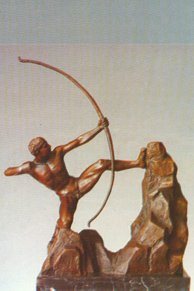
Dhanurveda (धनुर्वेद) refers to the “knowledge of warfare” and, as an upaveda, is associated with the Ṛgveda. It contains instructions on warfare, archery and ancient Indian martial arts, dating back to the 2nd-3rd millennium BCE.
Shaktism (Shakta philosophy)
Source: Wisdom Library: ŚāktismGandharva (गन्धर्व) refers to one of the 53 gods to be worshipped in the southern quarter and given pāyasa (rice boiled in milk) according to the Vāstuyāga rite in Śaktism (cf. Śāradātilaka-tantra III-V). The worship of these 53 gods happens after assigning them to one of the 64 compartment while constructing a Balimaṇḍapa. Vāstu is the name of a prodigious demon, who was killed by 53 gods (e.g., Gandharva).

Shakta (शाक्त, śākta) or Shaktism (śāktism) represents a tradition of Hinduism where the Goddess (Devi) is revered and worshipped. Shakta literature includes a range of scriptures, including various Agamas and Tantras, although its roots may be traced back to the Vedas.
Kavya (poetry)
Source: Shodhganga: The Kavyamimamsa of RajasekharaGandharva (गन्धर्व) is the name a locality mentioned in Rājaśekhara’s 10th-century Kāvyamīmāṃsā.—One of the nine parts of the Bhāratavarṣa, in the Kāvyamīmāṃsā. some of the Purāṇas mentioned it as Gāndharva. In the Uttarkanda (ch - cxiii, 10-11 and cxiv-11) in Rāmāyaṇa described this region is the valley of the Kābul, with a small tract of the land to the east of the Indus.

Kavya (काव्य, kavya) refers to Sanskrit poetry, a popular ancient Indian tradition of literature. There have been many Sanskrit poets over the ages, hailing from ancient India and beyond. This topic includes mahakavya, or ‘epic poetry’ and natya, or ‘dramatic poetry’.
Ayurveda (science of life)
Veterinary Medicine (The study and treatment of Animals)
Source: Shodhganga: Portrayal of Animal Kingdom (Tiryaks) in Epics An Analytical studyGandharva (गन्धर्व) (lit. “one who is a heavely singer”) is a synonym (another name) for the [Female] Cuckoo (Kokila), according to scientific texts such as the Mṛgapakṣiśāstra (Mriga-pakshi-shastra) or “the ancient Indian science of animals and birds” by Hamsadeva, containing the varieties and descriptions of the animals and birds seen in the Sanskrit Epics such as the Ramayana and Mahabharata.

Āyurveda (आयुर्वेद, ayurveda) is a branch of Indian science dealing with medicine, herbalism, taxology, anatomy, surgery, alchemy and related topics. Traditional practice of Āyurveda in ancient India dates back to at least the first millenium BC. Literature is commonly written in Sanskrit using various poetic metres.
Jyotisha (astronomy and astrology)
Source: Wisdom Library: Brihat Samhita by Varahamihira1) Gāndharva (गान्धर्व) refers to a country belonging to “Aiśānī (north-eastern division)” classified under the constellations of Revatī, Aśvinī and Bharaṇī, according to the system of Kūrmavibhāga, according to the Bṛhatsaṃhitā (chapter 14), an encyclopedic Sanskrit work written by Varāhamihira mainly focusing on the science of ancient Indian astronomy astronomy (Jyotiṣa).—Accordingly, “The countries of the Earth beginning from the centre of Bhāratavarṣa and going round the east, south-east, south, etc., are divided into 9 divisions corresponding to the 27 lunar asterisms at the rate of 3 for each division and beginning from Kṛttikā. The constellations of Revatī, Aśvinī and Bharaṇī represent the north-eastern consisting of [i.e., Gāndharva] [...]”.
2) Gāndharva (गान्धर्व) refers to “singers”, according to the Bṛhatsaṃhitā (chapter 15).—Accordingly, “[...] Those who are born on the lunar day of Mṛgaśirṣa will delight or deal in perfumes, dress, pearls, flowers, fruits, precious stones, wild beasts, birds and deer; will be Somayajis or singers (gāndharva); will be lascivious; will be good writers or painters. [...]”.

Jyotisha (ज्योतिष, jyotiṣa or jyotish) refers to ‘astronomy’ or “Vedic astrology” and represents the fifth of the six Vedangas (additional sciences to be studied along with the Vedas). Jyotisha concerns itself with the study and prediction of the movements of celestial bodies, in order to calculate the auspicious time for rituals and ceremonies.
Vastushastra (architecture)
Source: Brill: Śaivism and the Tantric Traditions (architecture)Gandharva (गन्धर्व) (or Gandharvaka) refers to one of the deities to be installed in the ground plan for the construction of houses, according to the Bṛhatkālottara, chapter 112 (the vāstuyāga-paṭala).—The plan for the construction is always in the form of a square. That square is divided into a grid of cells (padas). [...] Once these padas have been laid out, deities [e.g., Gandharva] are installed in them. In the most common pattern 45 deities are installed.
Gandharva as a doorway deity is associated with the Nakṣatra called Pūrvāṣāḍhā and the consequence is suśīlatā. [...] The Mayasaṃgraha (verse 5.156-187) describes a design for a 9-by-9-part pura, a residential complex for a community and its lead figure. [...] This record lists a place for singers at Gandharva.

Vastushastra (वास्तुशास्त्र, vāstuśāstra) refers to the ancient Indian science (shastra) of architecture (vastu), dealing with topics such architecture, sculpture, town-building, fort building and various other constructions. Vastu also deals with the philosophy of the architectural relation with the cosmic universe.
Shilpashastra (iconography)
Source: Shodhganga: Elements of Art and Architecture in the Trtiyakhanda of the Visnudharmottarapurana (shilpa)Gandharva (गन्धर्व) refers to a certain class of personalities which follows specific guidelines in the tradition of ancient Indian Painting (citra), according to the Viṣṇudharmottarapurāṇa, an ancient Sanskrit text which (being encyclopedic in nature) deals with a variety of cultural topics such as arts, architecture, music, grammar and astronomy.—In the Viṣṇudharmottarapurāṇa, the rules of Painting of different classes have been elaborately discussed. According to this work, the personalities like [e.g., Gandharva], [...] are to be drawn to project them as noble and polite. Like cloths, accessories of different character also vary in their pictures. The picture of deities and Gandharvas should be adorned with crests instead of crowns. Thus the Viṣṇudharmottarapurāṇa establishes the fact that even in the pictures; the people belonging to different class and profession [e.g., Gandharva] were projected with specific attire so that general people can equate the picture with the practical character.

Shilpashastra (शिल्पशास्त्र, śilpaśāstra) represents the ancient Indian science (shastra) of creative arts (shilpa) such as sculpture, iconography and painting. Closely related to Vastushastra (architecture), they often share the same literature.
General definition (in Hinduism)
Source: WikiPedia: HinduismGandharva (गंधर्व): A class of celestial beings regarded as specialists in music.
In Buddhism
Mahayana (major branch of Buddhism)
Source: Wisdom Library: Maha Prajnaparamita SastraGandharva (गन्धर्व) refers to “divine artists” accompanying the gods according to the 2nd century Mahāprajñāpāramitāśāstra (chapter XV). Accordingly, “The Gandharvas are divine artists who accompany the gods; their predispositions are gentle (mañju) but their merits, their qualities and their power are minimal; they are lower than the Devas and the Asuras. They are classed in the Asura destiny (asuragati), wheras the Nāgarājas, ‘dragon-kings’, are classed in the animal destiny (tiryaggati)”.
Also, “The king of the Gandharvas is called T’ong long mo (Druma) (in the Ts’in language, ‘tree’). Gandharvas and Kiṃnaras habitually reside in two places: their usual residence is on the Ten-Jewel Mountain (daśaratnagiri); but sometimes in the heavens, they play music for the gods. These two types of beings are not subject to the alternations of high and low ”.
Notes: The Gandharvas include in their ranks the heavenly musicians, Pañcasikha and Sūriyavaccasā, the daughter of Timbarū. In order to be reborn among the Gandharvas, it is enough to have practiced a lower form of śīla (Dīgha II). The Gandharvas form the lower group of gods (Dīgha II); they are the subjects of Dhṛtrarāṣtra, one of the four Cāturmahārājikadevas.
Gandharvas, together with other deities constitute the Asuras, according to chapter XLVI.—Accordingly, “great gods such as the Asuras, Kiṃnaras, Gandharvas, Kumbhāndas, Yakṣas, Rakṣasas, Bhūtas, etc., are Asuras, and when their troops increase, those of the Devas decrease. Their power (anubhāva) and their transformations (nirmāṇa) were exercised at will. The Asura destiny is called thus because the Asuras appear at the head of a list; the others, namely, the Kiṃnaras, Gandharvas, Kuṃbhāṇḍas, Yakṣas, Bhūtas, etc. constitute one and the same destiny with them”.

Mahayana (महायान, mahāyāna) is a major branch of Buddhism focusing on the path of a Bodhisattva (spiritual aspirants/ enlightened beings). Extant literature is vast and primarely composed in the Sanskrit language. There are many sūtras of which some of the earliest are the various Prajñāpāramitā sūtras.
Tibetan Buddhism (Vajrayana or tantric Buddhism)
Source: Wisdom Library: Tibetan Buddhism1) Gandharva (गन्धर्व) refers to a group of deities summoned by the Yamāntaka-mantra and mentioned as attending the teachings in the 6th century Mañjuśrīmūlakalpa: one of the largest Kriyā Tantras devoted to Mañjuśrī (the Bodhisattva of wisdom) representing an encyclopedia of knowledge primarily concerned with ritualistic elements in Buddhism. The teachings in this text originate from Mañjuśrī and were taught to and by Buddha Śākyamuni in the presence of a large audience (including Gandharva).
2) Gandharva (गन्धर्व) is also the name of a Rāśi (zodiac sign) mentioned as attending the teachings in the 6th century Mañjuśrīmūlakalpa.
Source: archive.org: The Indian Buddhist IconographyGandharva (गन्धर्व) refers to a group of deities commonly depicted in Buddhist Iconography, and mentioned in the 11th-century Niṣpannayogāvalī of Mahāpaṇḍita Abhayākara.—The Gandharva king is known by the name of Pañcaśikha and his form is described as follows:—“Pañcaśikha the king of the Gandharvas is yellow in colour and he plays on the vīṇā instrument”.

Tibetan Buddhism includes schools such as Nyingma, Kadampa, Kagyu and Gelug. Their primary canon of literature is divided in two broad categories: The Kangyur, which consists of Buddha’s words, and the Tengyur, which includes commentaries from various sources. Esotericism and tantra techniques (vajrayāna) are collected indepently.
General definition (in Buddhism)
Source: Wisdom Library: BuddhismGandharva:—Part man, part horse, (similar to the Greek Centaur) they were adept in the use of musical instruments.
Source: WikiPedia: BuddhismA Gandharva (Sanskrit) or Gandhabba (Pali) is one of the lowest ranking devas in Buddhist theology. They are classed among the Caturmaharajikakayika devas, and are subject to the Great King Dhrtarastra, Guardian of the East. Beings are reborn among the Gandharvas as a consequence of having practiced the most basic form of ethics (Janavasabha sutta, DN.18). It was considered embarrassing for a monk to be born in no better birth than that of a gandharva.
Gandharvas can fly through the air, and are known for their skill as musicians. They are connected with trees and flowers, and are described as dwelling in the scents of bark, sap, and blossom. They are among the beings of the wilderness that might disturb a monk meditating alone.
The terms gandharva and yaksa are sometimes used for the same person; yaksa in these cases is the more general term, including a variety of lower deities.Among the notable gandharvas are mentioned (in DN.20 and DN.32) Panada, Opamanna, Nala, Cittasena, Raja. Janesabha is probably the same as Janavasabha, a rebirth of King Bimbisara of Magadha. Matali the Gandharva is the charioteer for Sakra.
In Jainism
General definition (in Jainism)
Source: Wisdom Library: JainismGandharva (गन्धर्व).—The gandharvas are a group of deities categorised as belonging to the vyantara class of Gods (devas). The vyantaras represent a class of Gods (devas) comprising eight groups of deities that wander about the three worlds (adhaloka, madhyaloka and ūrdhvaloka).
Source: Google Books: Jaina IconographyGandharva (गन्धर्व).—A class of vyantara gods;—According to Tiloyapaṇṇatti, the ten Gandharvas are:
- Hāhā,
- Huhū,
- Nārada,
- Tumbara,
- Vāsava,
- Kadamba,
- Mahāsvara,
- Gītarati,
- Gītarasa,
- Vajravān.
Golden in appearance, they have the Tumbaru tree as their Caitya-tree
Accordign to Śvetāmbara Saṃgrahaṇī-sūtra, they are:
- Hāhā,
- Huhū,
- Tumburu,
- Nārada,
- Ṛṣivādika,
- Bhūtavādika,
- Kadamba,
- Mahākadamba,
- Raivata,
- Viśvāvasu,
- Gītarati,
- Gītayaśas.
The Gandharvas are blackish and beautiful in appearance, have excellent physiognomy, sweet voices and adorned with crowns and neckalces. The Tumbaru tree is their herald mark.
Source: archive.org: The Jaina IconographyGandharva (गन्धर्व) is the name of the Yakṣa accompanying Kunthanātha: the seventeenth of twenty-four Tīrthaṃkaras or Jinas, commonly depicted in Jaina iconography.—Jaina tradition as preserved in their literature, has always connected the symbol of a goat with this Tīrthaṃkara. He has as his Yakṣa Gandharva and Yakṣiṇī Balā (Digambara: Vijayā). The contemporary King, who carries his Chowrie-bearer is called Kuṇāla. The tree selected by him to sit under for attaining the Kevala knowledge is Tilaka-taru.
The Digambara account makes this [Gandharva] Yakṣa to ride a bird and bear four hands. The symbols held in them are a snake, noose, bow etc. The Śvetāmbara representation shows a swan as his vehicle and his four hands holding a Varada, noose, citrus and goad.
Source: archive.org: TrisastisalakapurusacaritraGandharva (गन्धर्व) is the name of the Yakṣa (i.e., Śāsanadevatās, ‘messenger-deities’) associated with Kunthu, according to chapter 6.1 [kunthusvāmi-caritra] of Hemacandra’s 11th century Triṣaṣṭiśalākāpuruṣacaritra: an ancient Sanskrit epic poem narrating the history and legends of sixty-three illustrious persons in Jainism.
Accordingly:—“Originating in the congregation, the Yakṣa Gandharva, with a haṃsa for a vehicle, dark, with one right arm in the boon-granting position and one holding a noose, with left arms holding a citron and a goad, became the messenger-deity of Śrī Kunthunātha. Originating in that congregation, the goddess Balā, fair-bodied, with a peacock for a vehicle, with right arms holding a citron and a trident, with left arms holding a muṣaṇḍhī and a lotus, always near, became the Lord’s messenger-deity”.
Source: Encyclopedia of Jainism: Tattvartha Sutra 4: The celestial beings (deva)Gandharva (गन्धर्व) refers to the “musician” class of “peripatetic celestial beings” (vyantara), itself a category of devas (celestial beings), according to the 2nd-century Tattvārthasūtra 4.10. Who are the lords amongst the musician (gandharva) class of peripatetic (forest) celestial beings? Gītarati and Gītayaśa are the two lords in the musician class of peripatetic celestial beings.

Jainism is an Indian religion of Dharma whose doctrine revolves around harmlessness (ahimsa) towards every living being. The two major branches (Digambara and Svetambara) of Jainism stimulate self-control (or, shramana, ‘self-reliance’) and spiritual development through a path of peace for the soul to progess to the ultimate goal.
India history and geography
Source: Cologne Digital Sanskrit Dictionaries: Indian Epigraphical GlossaryGāndharva.—(EI 28), dance and music. Note: gāndharva is defined in the “Indian epigraphical glossary” as it can be found on ancient inscriptions commonly written in Sanskrit, Prakrit or Dravidian languages.
Source: Singhi Jain Series: Ratnaprabha-suri’s Kuvalayamala-katha (history)Gandharva (गन्धर्व) refers to one of the deities being worshiped in ancient India, as vividly depicted in the Kathās (narrative poems) such as Uddyotanasūri in his 8th-century Kuvalayamālā (a Prakrit Campū, similar to Kāvya poetry).—The Kuvalayamala (779 A.D.) is full of cultural material which gains in value because of the firm date of its composition. [...] Page 256.31-2 ff.: Here is a mixed list of 25 gods and Godlings of all religions. These were worshipped and propitiated to obtain favours. The list includes [e.g., Gandharva] [...].
Source: Academia: Ritual Period: A Comparative Study of Three Newar Buddhist Menarche ManualsGandharva (गन्धर्व) refers to “heavenly musicians”, according to the “Vādhā byaṃ ke vidhi”: the name of two manuscripts written by (1) Kathmandu-based priest, Badriratna Bajracharya and (2) Buddharatna Bajracharya from Lalitpur.—Badriratna’s text pays the most attention to the invocations of celestial bodies and other cosmologically grouped agents. The list consists of [e.g., heavenly musicians (gandharvas)]. In this list, we particularly find the dark forces that are especially adept at causing problems for women, children and, more specifically, girl children, addressed and harnessed.

The history of India traces the identification of countries, villages, towns and other regions of India, as well as mythology, zoology, royal dynasties, rulers, tribes, local festivities and traditions and regional languages. Ancient India enjoyed religious freedom and encourages the path of Dharma, a concept common to Buddhism, Hinduism, and Jainism.
Languages of India and abroad
Marathi-English dictionary
Source: DDSA: The Molesworth Marathi and English Dictionarygandharva (गंधर्व).—m (S) A celestial chorister. These are a class of demigods. They inhabit Swarga and form the orchestra of the principal deities. 2 fig. An extraordinary vocalist or musician.
--- OR ---
gāndharva (गांधर्व).—n S Song, singing, vocal music.
Source: DDSA: The Aryabhusan school dictionary, Marathi-Englishgandharva (गंधर्व).—m A celestial chorister. Fig. An extraordinary vocalist or musician.
--- OR ---
gāndharva (गांधर्व).—n Song, singing, vocal music.
Marathi is an Indo-European language having over 70 million native speakers people in (predominantly) Maharashtra India. Marathi, like many other Indo-Aryan languages, evolved from early forms of Prakrit, which itself is a subset of Sanskrit, one of the most ancient languages of the world.
Sanskrit dictionary
Source: DDSA: The practical Sanskrit-English dictionaryGandharva (गन्धर्व).—
1) A celestial musician, a class of demi-gods regarded as the singers or musicians of gods, and said to give good and agreeable voice to girls; पतङ्गो वाचं मनसा बिभर्ति तां गन्धर्वोऽवदद्गर्भे अन्तः (pataṅgo vācaṃ manasā bibharti tāṃ gandharvo'vadadgarbhe antaḥ) Ṛgveda 1.177.2; Av.11.5.2; सोमं शौचं ददावासां गन्धर्वश्च शुभां गिरम् (somaṃ śaucaṃ dadāvāsāṃ gandharvaśca śubhāṃ giram) Y.1.71.
2) A singer in general; Mahābhārata (Bombay) 7.57.4.
3) A horse; Mahābhārata (Bombay) 3.
4) The musk-deer.
5) The soul after death and previous to its being born again; तस्यासीद्दुहिता गन्धर्वगृहीता (tasyāsīdduhitā gandharvagṛhītā) Bṛ. Up.3.3.1.
6) The black cuckoo.
7) The sun.
8) A sage, pious man; Vāj.32.7.
Derivable forms: gandharvaḥ (गन्धर्वः).
--- OR ---
Gāndharva (गान्धर्व).—a. (-rvī f.) [गन्धर्वस्येदम्-अण् (gandharvasyedam-aṇ)] Relating to the Gandharvas.
-rvaḥ 1 A singer, celestial chorister; Rām.7.94.6.
2) One of the eight forms of marriage; गान्धर्वः समयान्मिथः (gāndharvaḥ samayānmithaḥ) Y.1.61; (for explanation, see gandharva- vivāha); cf. अग्निर्गान्धर्वी पथ्यामृतस्या (agnirgāndharvī pathyāmṛtasyā) Ṛgveda 1.8.6.
3) A subordinate Veda treating of music attached to the Sāmaveda; see उपवेद (upaveda).
4) A horse.
-rvam The art of the Gandharvas; i. e. music, singing; कापि वेला चारुदत्तस्य गान्धर्व श्रोतुं गतस्य (kāpi velā cārudattasya gāndharva śrotuṃ gatasya) Mṛcchakaṭika 3; अये गान्धर्वध्वनिरिव श्रूयते (aye gāndharvadhvaniriva śrūyate) Avimārakam 3; Kathāsaritsāgara 12.28.
-rvī 1 Speech.
2) An epithet of Durgā.
Source: Cologne Digital Sanskrit Dictionaries: Edgerton Buddhist Hybrid Sanskrit DictionaryGandharva (गन्धर्व).—m. (compare Pali gandhabbā, f., and Sanskrit gāndharva, nt., id.), music: Mahāvyutpatti 4954 (so also Mironov; short a may be MIndic, but note gender!) = Tibetan rol mo.
--- OR ---
Gāndharva (गान्धर्व).—name of a cakravartin: Mahāvastu i.153.16.
Source: Cologne Digital Sanskrit Dictionaries: Benfey Sanskrit-English DictionaryGandharva (गन्धर्व).—and rba rba, I. m. A Gandharva: in epic poetry the Gandharvas are demigods inhabiting Indra's heaven, and serving as celestial musicians, Mahābhārata 1, 4806. Ii. f. vī. 1. A female Gandharva, [Bhāgavata-Purāṇa, (ed. Burnouf.)] 4, 29, 21. 2. A mythological person, [Rāmāyaṇa] 3, 20, 28; 29.
--- OR ---
Gāndharva (गान्धर्व).—i. e. gandharva + a, I. adj., f. vī. 1. Referable or belonging to the Gandharvas, Mahābhārata 7, 6348; [Rāmāyaṇa] 1, 29, 15. 2. m. viz. vivāha, A form of marriage, that which requires only mutual agreement, [Mānavadharmaśāstra] 3, 21. 3. Musical, Mahābhārata 3, 8421. 4. Possessed by the Gandharvas, [Suśruta] 1, 332, 21. Ii. n. Music and dance, Mahābhārata 13, 1427.
Source: Cologne Digital Sanskrit Dictionaries: Cappeller Sanskrit-English DictionaryGandharva (गन्धर्व).—[masculine] [Name] of a genius, connected with Soma and the Sun; [with] apām = garbha; later mostly [plural] the heavenly singers.
--- OR ---
Gāndharva (गान्धर्व).—[feminine] gāndharvī belonging or peculiar to the Gandharvas, [especially] [with] vivāha or vidhi [masculine] a marriage without any ceremony; [masculine] a singer, [plural] [Name] of a people; [neuter] the art of the Gandharvas i.e. song, music.
Source: Cologne Digital Sanskrit Dictionaries: Monier-Williams Sanskrit-English Dictionary1) Gandharva (गन्धर्व):—m. a Gandharva [though in later times the Gandharvas are regarded as a class, yet in [Ṛg-veda] rarely more than one is mentioned; he is designated as the heavenly Gandharva (divya g, [Ṛg-veda ix, 86, 36 and x, 139, 5]), and is also called Viśvā-vasu ([Ṛg-veda x, 85, 21 and 22; 139, 4 and 5]) and Vāyu-keśa (in [plural] [Ṛg-veda iii, 38, 6]); his habitation is the sky, or the region of the air and the heavenly waters ([Ṛg-veda i, 22, 14; viii, 77, 5; ix, 85, 12; 86, 36; x, 10, 4; Atharva-veda ii, 2, 3]); his especial duty is to guard the heavenly Soma ([Ṛg-veda ix, 83, 4 and 85, 12]), which the gods obtain through his intervention ([Ṛg-veda; Atharva-veda vii, 73, 3]; cf. [Ṛg-veda i, 22, 14]); it is obtained for the human race by Indra, who conquers the Gandharva and takes it by force ([Ṛg-veda viii, 1, 11 and 77, 5]); the heavenly Gandharva is supposed to be a good physician, because the Soma is considered as the best medicine; possibly, however, the word Soma originally denoted not the beverage so called, but the moon, and the heavenly Gandharva may have been the genius or tutelary deity of the moon; in one passage ([Ṛg-veda ix, 86, 36]) the heavenly Gandharva and the Soma are identified; he is also regarded as one of the genii who regulate the course of the Sun’s horses ([i, 163, 2; x, 177, 2]; cf. [135, 5]); he knows and makes known the secrets of heaven and divine truths generally ([x, 139, 5 and 6; Atharva-veda ii, 1, 2; xx, 128, 3; Vājasaneyi-saṃhitā xi, 1; xxxii, 9]); he is the parent of the first pair of human beings, Yama and Yamī ([Ṛg-veda x, 10, 4]), and has a peculiar mystical power over women and a right to possess them ([Ṛg-veda x, 85, 21 and 22; 40 and 41]); for this reason he is invoked in marriage ceremonies ([Atharva-veda xiv, 2, 35 and 36]); ecstatic states of mind and possession by evil spirits are supposed to be derived from the heavenly Gandharva (cf. -gṛhīta, -graha); the Gandharvas as a class have the same characteristic features as the one Gandharva; they live in the sky ([Ṛg-veda; Atharva-veda; Śatapatha-brāhmaṇa xiv]), guard the Soma ([Ṛg-veda ix, 113, 3; Śatapatha-brāhmaṇa iii; Aitareya-brāhmaṇa i, 27]), are governed by Varuṇa (just as the Apsarasas are governed by Soma), [Śatapatha-brāhmaṇa xiii; Āśvalāyana-śrauta-sūtra x, 7, 3], know the best medicines ([Atharva-veda viii, 7, 23; Vājasaneyi-saṃhitā xii, 98]), regulate the course of the asterisms ([Atharva-veda xiii, 1, 23; Bhāgavata-purāṇa iv, 29, 21]; hence twenty-seven are mentioned, [Vājasaneyi-saṃhitā ix, 7]), follow after women and are desirous of intercourse with them ([Atharva-veda; Śatapatha-brāhmaṇa iii]); as soon as a girl becomes marriageable, she belongs to Soma, the Gandharvas, and Agni ([Gṛhyāsaṃgraha ii, 19 f.; Pañcatantra; Suśruta]); the wives of the Gandharvas are the Apsarasas (cf. gandharvāpsaras), and like them the Gandharvas are invoked in gambling with dice ([Atharva-veda vii, 109, 5]); they are also feared as evil beings together with the Rākṣasas, Kimīdins, Piśācas, etc., amulets being worn as a protection against them ([Atharva-veda; Suśruta]); they are said to have revealed the Vedas to Vāc ([Śatapatha-brāhmaṇa iii]; cf. [Pāraskara-gṛhya-sūtra ii, 12, 2]), and are called the preceptors of the Ṛṣis ([Śatapatha-brāhmaṇa xi]); Purūravas is called among them ([ib.]); in epic poetry the Gandharvas are the celestial musicians or heavenly singers (cf. [Ṛg-veda x, 177, 2]) who form the orchestra at the banquets of the gods, and they belong together with the Apsarasas to Indra’s heaven, sharing also in his battles ([Yājñavalkya i, 71; Mahābhārata; Harivaṃśa] etc.; cf. [Religious Thought and Life in India p.238]); in the more systematic mythology the Gandharvas constitute one of the classes into which the higher creation is divided (id est. gods, manes, Gandharvas, [Atharva-veda xi, 5, 2]; or gods, Asuras, Gandharvas, men, [Taittirīya-saṃhitā vii, 8, 25, 2]; cf. [Śatapatha-brāhmaṇa x]; or gods, men, Gandharvas, Apsarasas, Sarpas, and manes, [Aitareya-brāhmaṇa iii, 31, 5]; for other enumerations cf. [Nirukta, by Yāska iii, 8; Manu-smṛti i, 37] [Religious Thought and Life in India p.237] [&iii, 196; vii, 23; xii, 47; Nalopākhyāna] etc.); divine and human Gandharvas are distinguished ([Taittirīya-upaniṣad ii, 8]; the divine or Deva-Gandharvas are enumerated, [Mahābhārata i, 2550 ff. and 4810 ff.]); another passage names 11 classes of Gandharvas ([Taittirīya-āraṇyaka i, 9, 3]); the chief or leader of the Gandharvas is named Citra-ratha ([Bhagavad-gītā x, 26]); they are called the creatures of Prajāpati ([Manu-smṛti i, 37]) or of Brahmā ([Harivaṃśa 11793]) or of Kaśyapa ([11850]) or of the Munis ([Mahābhārata i, 2550; Harivaṃśa 11553]) or of Prādhā ([Mahābhārata i, 2556]) or of Ariṣṭā ([Harivaṃśa 234; Viṣṇu-purāṇa i, 21]) or of Vāc ([Padma-purāṇa]); with Jainas the Gandharvas constitute one of the eight classes of the Vyantaras]
2) Name of the attendant of the 17th Arhat of the present Avasarpiṇī, [cf. Lexicographers, esp. such as amarasiṃha, halāyudha, hemacandra, etc.]
3) a singer, [Varāha-mihira’s Bṛhat-saṃhitā lxxxvii, 33; Bhāgavata-purāṇa i, 11, 21]
4) the Koïl or black cuckoo, [cf. Lexicographers, esp. such as amarasiṃha, halāyudha, hemacandra, etc.]
5) a sage, pious man, [Mahīdhara on Vājasaneyi-saṃhitā xxxii, 9]
6) a horse, [Mahābhārata iii, 11762]
7) cf. [ii, 1043]
8) the musk deer (derived [from] gandha), [cf. Lexicographers, esp. such as amarasiṃha, halāyudha, hemacandra, etc.]
9) the soul after death and previous to its being born again (corresponding in some respects to the western notion of a ghost), [cf. Lexicographers, esp. such as amarasiṃha, halāyudha, hemacandra, etc.]
10) Name of the 14th Kalpa or period of the world, [Vāyu-purāṇa i, 21, 30]
11) of the 21st Muhūrta, [Sūryaprajñapti]
12) of a Svara or tone (for gāndhāra?), [Harivaṃśa ii, 120, 4]
13) m. [plural] the Gandharvas (See above)
14) m. Name of a people (named together with the Gāndhāras), [Rāmāyaṇa vii, 100, 10 f. and 101, 2 ff. and 11; Varāha-mihira’s Bṛhat-saṃhitā xiv, 31]
15) Gandharvā (गन्धर्वा):—[from gandharva] f. Durgā, [Harivaṃśa ii, 120, 4] ([varia lectio] gāndharvī)
16) Gandharva (गन्धर्व):—(cf. [Greek] κένταυρος [from] κενθαρϝο-ς.)
17) Gāndharva (गान्धर्व):—mf(gāndharvī-)n. belonging or relating to the Gandharvas (especially vivāha, or vidhi, the form of marriage called after the Gandharvas which requires only mutual agreement, [Āśvalāyana-gṛhya-sūtra i, 6, 5; Manu-smṛti; Yājñavalkya; Mahābhārata i, etc.] ; cf. gandharva-vivāha), [Ṛg-veda x, 80, 6; Śatapatha-brāhmaṇa xiv etc.]
18) relating to the Gandharvas as heavenly choristers (cf. -kalā, -veda, etc.), [Mahābhārata; Harivaṃśa] etc.
19) m. (= gandh [gana] prajñādi, [Gaṇaratna-mahodadhi 175]) a singer, [Rāmāyaṇa vii, 94, 6; Varāha-mihira’s Bṛhat-saṃhitā xv, xxxii]
20) Name of a musical note, [Harivaṃśa 16291; Vāyu-purāṇa i, 21, 30]
21) of one of the 9 divisions of Bhārata-varṣa, [Viṣṇu-purāṇa ii, 3, 7]
22) n. the art of the Gandharvas, song, music, concert, [Mahābhārata; Harivaṃśa] etc.
23) Name of a Tantra
Source: Cologne Digital Sanskrit Dictionaries: Yates Sanskrit-English DictionaryGandharva (गन्धर्व):—(rvvaḥ) 1. m. A celestial musician; a horse; a deer; a disembodied spirit; a cuckoo; the sun; a sage; a form of marriage.
Source: DDSA: Paia-sadda-mahannavo; a comprehensive Prakrit Hindi dictionary (S)Gandharva (गन्धर्व) in the Sanskrit language is related to the Prakrit words: Gaṃdhavva, Gadhavva.
[Sanskrit to German]
Sanskrit, also spelled संस्कृतम् (saṃskṛtam), is an ancient language of India commonly seen as the grandmother of the Indo-European language family (even English!). Closely allied with Prakrit and Pali, Sanskrit is more exhaustive in both grammar and terms and has the most extensive collection of literature in the world, greatly surpassing its sister-languages Greek and Latin.
Kannada-English dictionary
Source: Alar: Kannada-English corpusGaṃdharva (ಗಂಧರ್ವ):—
1) [noun] a class of gods, considered as celestial musicians.
2) [noun] a member of that class.
3) [noun] the soul after death and previous to its being born again.
4) [noun] a musician in general.
5) [noun] a horse.
6) [noun] a small, hornless deer (Moschus moschiferus) of the uplands of central Asia, the male of which secretes musk and has tusk-like upper canines; a musk-deer.
7) [noun] any of various large cuckoos (mainly either Cuculus tenuirostris or C. lathami) of the Eudynamys genus of India, that lay eggs in the nests of other birds and is noted for its characteristic soft cry; Indian cuckoo; a koel.
8) [noun] a kind of bee; a black bee.
9) [noun] the sun.
10) [noun] the art and science of combining vocal or instrumental sounds or tones in varying melody, harmony, rhythm, and timbre; music.
11) [noun] a woman in general.
12) [noun] a religious, wise man; a sage.
--- OR ---
Gaṃdharvadūrve (ಗಂಧರ್ವದೂರ್ವೆ):—[noun] = ಗಂಧರ್ವಗಱುಕೆ [gamdharvagaruke].
--- OR ---
Gāṃdharva (ಗಾಂಧರ್ವ):—[adjective] of or relating to Gandharvas, a class of gods.
--- OR ---
Gāṃdharva (ಗಾಂಧರ್ವ):—
1) [noun] the art of music.
2) [noun] the art of dance.
3) [noun] an excellent horse.
4) [noun] Gandharvas, a class of gods.
Kannada is a Dravidian language (as opposed to the Indo-European language family) mainly spoken in the southwestern region of India.
See also (Relevant definitions)
Starts with (+42): Gamdharvagaruke, Gamdharvajna, Gamdharvamsha, Gamdharvasrishti, Gamdharvavidye, Gandharva-vidhya, Gandharvachitta, Gandharvacitta, Gandharvadatta, Gandharvagana, Gandharvagayana, Gandharvagita, Gandharvagraha, Gandharvagrihita, Gandharvahasta, Gandharvahastadi, Gandharvahastaka, Gandharvahastakah, Gandharvaka, Gandharvakala.
Ends with: Devagandharva, Mahagandharva, Manushyagandharva, Sagandharva, Samigandharva, Sarvagandharva, Tantragandharva, Upagandharva, Yuddhagandharva.
Full-text (+1058): Gandharvaveda, Vishvavasu, Gandharvavidya, Gandharvavivaha, Gandharvacitta, Huhu, Gandharvaraja, Tumburu, Yuddhagandharva, Citrasena, Padmashekhara, Gandharvakala, Caitraratha, Gandharvaka, Devagandharva, Citraratha, Gandharvagrihita, Manojnasvara, Gandharvapsaras, Manushyagandharva.
Relevant text
Search found 216 books and stories containing Gandharva, Gamdharva, Gaṃdharva, Gāṃdharva, Gamdharvadurve, Gaṃdharvadūrve, Gāndharva, Gandharvā, Gandharvadurve, Gandharvadūrve; (plurals include: Gandharvas, Gamdharvas, Gaṃdharvas, Gāṃdharvas, Gamdharvadurves, Gaṃdharvadūrves, Gāndharvas, Gandharvās, Gandharvadurves, Gandharvadūrves). You can also click to the full overview containing English textual excerpts. Below are direct links for the most relevant articles:
Women in the Atharva-veda Samhita (by Pranab Jyoti Kalita)
2. Goddess Apsarases < [Chapter 4 - Female Deities and the Glorification of Women in the Atharvaveda]
2. Hymns to Obtain a Husband < [Chapter 2 - The Strīkarmāṇi Hymns of the Atharvaveda]
5e. Practice of Polygamy and Polyandry < [Chapter 3 - The Familial and Social Life of Women in the Atharvaveda]
Garga Samhita (English) (by Danavir Goswami)
Verse 5.8.45 < [Chapter 8 - The Killing of Kaṃsa]
Verses 1.11.22-24 < [Chapter 11 - Description of Śrī Kṛṣṇacandra’s Birth]
Verse 4.9.12 < [Chapter 9 - The Glories of Srī Ekādaśī]
Rivers in Ancient India (study) (by Archana Sarma)
3c. The Legend of Vāk in the Aitareya-brāhmaṇa < [Chapter 3 - The Rivers in the Brāhmaṇa Literature]
3d. The legend of Vāk in the Śatapatha-brāhmaṇa < [Chapter 3 - The Rivers in the Brāhmaṇa Literature]
6. The river Narmadā in the Purāṇas < [Chapter 5 - Rivers in the Purāṇic Literature]
Gati in Theory and Practice (by Dr. Sujatha Mohan)
References to drama, dance and music in Sanskrit literature < [Chapter 1 - Nāṭya]
Gati in aerial sphere < [Chapter 3 - Application of gati in Dṛśya-kāvyas]
Analysis of technical terms: Nāṭya, Nṛtta, Nṛtya < [Chapter 1 - Nāṭya]
Rig Veda (translation and commentary) (by H. H. Wilson)
The Markandeya Purana (Study) (by Chandamita Bhattacharya)
Forms of Marriage < [Chapter 2]
Divisions of Āśrama (Introduction) < [Chapter 2]
Related products
